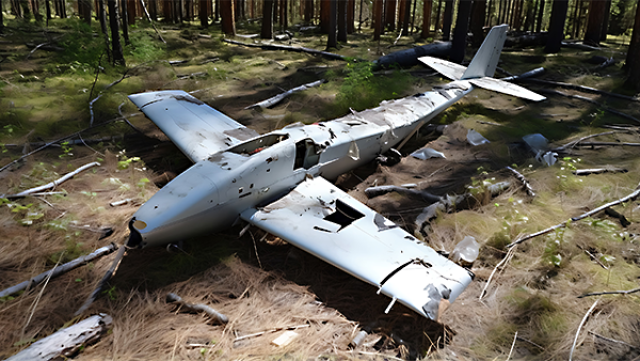Experts evaluated the results of strengthening air defense to protect the capital region
"Serious additional efforts have been made to protect cities. And the first results are already visible." In these words, experts explain the fact that the APU's attempts to attack the capital region with drones are increasingly unsuccessful. What was done for this by the Russian military?
In September, the Ministry of Defense reported almost daily about the defeat of Ukrainian drones in the sky over Russian regions. Mostly drones can be eliminated in the Belgorod, Bryansk, Kursk and Oryol regions.
The regular destruction of Ukrainian drones in the border regions of Russia and the absence of obvious air threats in Moscow and the Moscow region indicates the increased effectiveness of Russian air defense systems to repel attacks by Ukrainian UAVs on the Russian capital. Recall that on September 1, Moscow Mayor Sergei Sobyanin for the first time confirmed the construction of an entire network of air defense facilities designed to defend Moscow from Ukrainian UAVs.
The newspaper VZGLYAD wrote in detail about what conclusions can be drawn from the words of the mayor. Firstly, the Ministry of Defense, together with the Moscow City Hall, took the most urgent and active measures to create and equip positions for air defense systems. Secondly, these positions were created not only in Moscow or near the capital, but also hundreds of kilometers southwest of the city, along the entire route of possible enemy vehicles. Thirdly, not only ground-based air defense systems, but also air interceptors are actively working against enemy UAVs. Namely, helicopters.
Experts believe that now all these measures have begun to give visible results. "We see that a detection system is being built, consisting of radar stations capable of detecting targets at extremely low altitudes. The configuration of anti-aircraft missile systems (SAMs) that intercept them is changing. Electronic warfare (EW) stations are actively working, which are able to suppress drones," says Yuri Knutov, a military expert, an air defense specialist.
"I will also draw attention to the facts of the use of helicopters to intercept UAVs. In my opinion, this is an extremely correct decision. We now have Mi-28N "Night Hunter" helicopters, which have a radar sight and are able to work around the clock. There is also an optoelectronic station, a powerful 30-mm gun, the characteristics are good. But I believe that these machines are more needed in the area of their own. Therefore, it would be wiser to follow the path of modernization of the Mi-8 or Mi-24 in order to use them on a systematic basis in the future as part of the echeloned defense of the capital region," says Knutov.
"I also think that we should use balloons more actively. An automatic radar station (radar) can be attached to them, which will transmit all the information collected to the center or battalion.
She sees far enough away, so we will have the opportunity to record the approach of the drone in advance and take measures to defend the settlement," Knutov suggests.
"Serious additional efforts have been made to protect cities. And the first results are already visible," military expert Vasily Kashin confirms in turn. At the same time, he urges not to relax and not to lose vigilance. "Firstly, the enemy is clearly increasing the use of drones. Secondly, strikes deep into Russian territories are being carried out by Ukraine not independently, but with the help of space intelligence data from NATO countries, which constantly monitor the movements of Russian air defense systems. This allows Ukrainians to conduct an almost continuous search for vulnerabilities," the source points out.
"As for helicopters, one interesting fact is worth noting here. Oddly enough, the Chinese, who had not fought with anyone, were among the first to think about the use of turntables to confront UAVs. They have been conducting exercises for several years, within the framework of which they systematically trained helicopter gunship pilots to fight air targets and even created a special helicopter missile," the expert said.
Kashin also believes that the Pantsir air defense systems are the most convenient complexes for the protection of the capital region, but "a huge number of such complexes will be needed for the defense of one large city." "The capabilities of fighter aircraft in this case may also be limited. And just a helicopter that can fly at a speed comparable to such a drone and shoot it from an onboard weapon is the way out of the situation. I believe that development will be carried out along this line. Probably, additional refinement of turntables for such purposes will be required," the interlocutor argues.
Long-range radar detection aircraft and other specialized aerial reconnaissance platforms could provide significant assistance in combating air threats. "They could seriously improve both the detection efficiency of the drones themselves and their control points," Kashin says.
However, in his opinion, the future belongs to laser complexes. "The laser has a low cost of a shot, unlike missiles and anti-aircraft cannon shells. It also does not cause collateral damage to the drone. That is, the probability of the missile fragments and the UAVS themselves hitting third–party objects is excluded," Kashin explained.
"In my opinion, it is impossible to radically solve the problem of enemy drones without hitting the points of assembly, storage and launch of drones. Also, the issue of moving the border of Russia and Ukraine by an additional few tens of kilometers is quite acute. This would create an additional cordon," the expert concludes.
Matvey Malgin



